仪表等级飞行员理论培训stage1-101 Human Factors
飞行员国外培训飞行的培训一共分为三个大的阶段,私照(PPL)、仪表等级(IR)、多发商照(MECPL

一般情况下,从出国到达航校开始,你的培训就开始了,从达到航校到离开航校之前,英语都是大家学习的重点,这个也是国内航空公司送大家出国培训的一个原因,英语的培训可以分为两个方面,第一是日常英语,这个是大家在国外立足生活的根本。
另外一方面的是陆空通话,陆空通话是大家飞行的一个重点,基本的飞行大家都没有问题,但是问题往往就是陆空通话是大家的难点。
飞行的培训一共分为三个大的阶段,私照(PPL)、仪表等级(IR)、多发商照(MECPL),其中每个阶段都是40课。
每个阶段一般都分为不同的小的阶段分别对学习的内容进行考核,每小个阶段的考核基本都分为两部分——口试部分和飞行部分,口试部分先进行,如果口试部分不通过,则不进行飞行部分的考试,如果考核不通过则重新和教员进行复习飞行,直到考核通过则进行下一个阶段的学习。
私照(PPL)共分为3个阶段,其中第一阶段为第19课,口试的内容包含:Takeoff and landing Data / Weight and Balance / Weather(起飞着陆的数据的计算/装载和配平的计算/基本的天气信息的获得和分析)、FAR Part 61 and 91(联邦航空飞行条例61部和91部相关内容)、Airspace pertaining to the local airports and practice areas (与飞行训练区和训练机场有关的空域分析)、Performance and Limitations of the PA 28—181(训练用飞机PA28—181的基本性能参数和限制);飞行的学习和考核的内容包含:Normal Crosswind Takeoffs(正常和侧风起飞)、Traffic Pattern Operations(起落航线的操作)、Normal and Crosswind Landings(正常和侧风情况下的降落)、Steep Turn(大坡度转弯)、Slow Flight(慢速飞行)、Stalls(失速:带动力和不带动力失速)、Emergency Landings(紧急着陆)、ATC Communications(陆空通话)、Rejected Landing(中断着陆、复飞)。
仪表等级理论训练大纲-仪表飞行规则
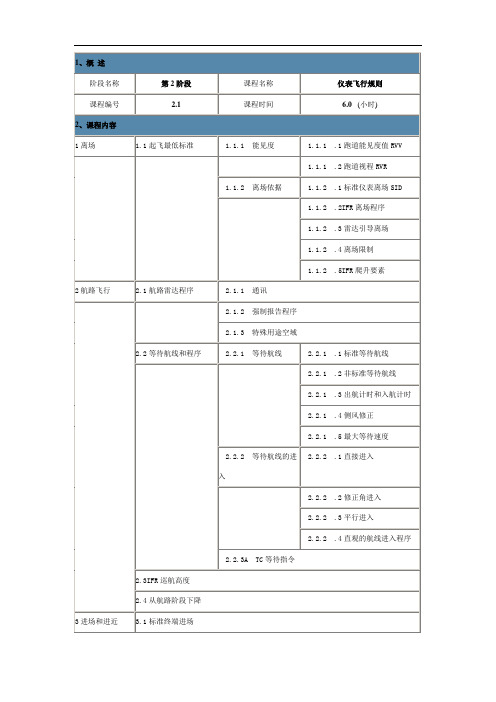
3.2.3 .1反向程序
3.2.3 .2从一个定位点计时进入
3.2.3 .3计划非精密进近
3.2.3 .4盘旋进近程序
3.2.3 .5盘旋进近着陆的要素
3.3复飞
3.4目视进近和能见地面进近
3.4.1目视进近
3.4.2能见地面进近
3.4.2 .1使用目视进近坡度指示灯
3.4.2 .2侧滑机动飞行旁侧着陆
1.1.2 .4离场限制
1.1.2 .5IFR爬升要素
2航路飞行
2.1航路雷达程序
2.1.1通讯
2.1.2强制报告程序
2.1.3特殊用途空域
2.2等待航线和程序
2.2.1等待航线
2.2.1 .1标准等待航线
2.2.1 .2非标准等待航线
2.2.1 .3出航计时和入航计时
2.2.1 .4侧风修正
2.2.1 .5最大等待速度
3.4.2 .3跑道目视幻觉
3.5终止IFR飞行计划
2.2.2等待航线的进入
2.2.2 .1直接进入
2.2.2 .2修正角进入
2.2.2 .3平行进入
2.2.2 .4直观的航航高度
2.4从航路阶段下降
3进场和进近
3.1标准终端进场
3.2使用ATC雷达进近
3.2.1最低雷达引导高度
3.2.2雷达引导到最后进近航道
1、概述
阶段名称
第2阶段
课程名称
仪表飞行规则
课程编号
2.1
课程时间
6.0(小时)
2、课程内容
1离场
1.1起飞最低标准
1.1.1能见度
1.1.1 .1跑道能见度值RVV
1.1.1 .2跑道视程RVR
OA自动化-仪表等级飞行员理论培训 精品
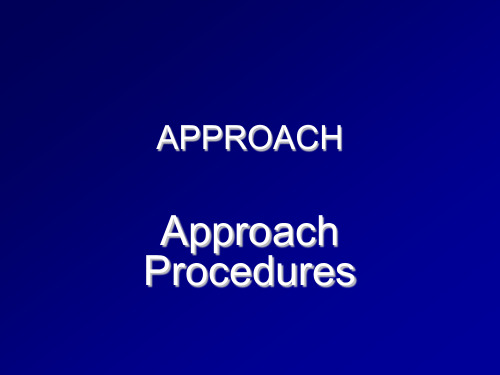
Final segment of ILS approach (precision)
The Glide Slope
Note final segment of this NDB Approach (non-precision with FAF)
–Initial –Intermediate –Final –Missed Approach
Five segments if you count the up front feeder route.
Segments of an Approach
Initial Approach Segment
Aligns your aircraft with the approach course
–Intermediate fix (IF) –Begins at point where you are
eding inbound to the final approach fix, properly aligned. –Not all approaches have an intermediate fix
APPROACH
Approach Procedures
Safely Finding The Airport
Precision Approaches
Precision Approaches provide vertical guidance in addition to lateral guidance, most often through the use of an electronic glideslope. Precision Approaches include:
仪表等级飞行员理论培训stage1-104 PITOT-STATIC资料
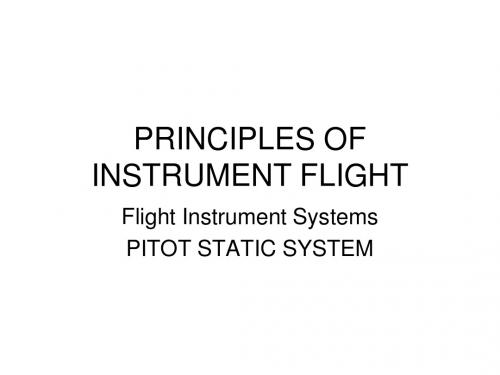
International Standard Atmosphere
• ISA
– Standard Sea level Pressure 29.92 Hg. • 1013.2 Mb. – Standard temperature • Sea Level 15 C (59 F) • Standard Lapse rate 2 C per 1000 feet
Airspeed Indicator Measures pressure differential
•
Types of Airspeed:acronym “ICET ” Indicated airspeed
– Indication on airspeed indicator – Use same indicated airspeed for take-off & landing regardless of altitude or temperature
– Indicated – Pressure – Density – True – Absolute
Altitude types are different because of reference point. • Indicated altitude
– what you read when barometric pressure is set to current altimeter setting – IFR below 18,000’ MSL
– Airspeed (AI) – Altimeter (ALT) – Vertical Speed (VSI)
– AIRSPEED INDICATOR
Airspeed Indicator
仪表等级飞行员理论培训stage5210APPROACHPROCEDURES
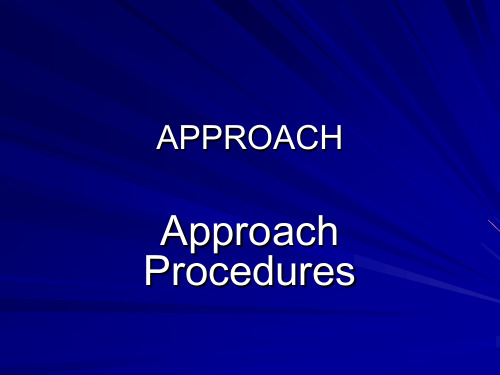
Approach Procedures
Safely Finding The Airport
Precision Approaches
Precision Approaches provide vertical guidance in addition to lateral guidance, most often through the use of an electronic glideslope. Precision Approaches include:
Final Segment of a VOR Approach (non-precision with FAP)
Missed Approach Segment
Navigate from MAP to missed approach holding point. Depicted on every approach
• NDB
• RNAV (GPS)
• ASR – Airport Surveillance Radar
• Localizer (front & back courses)
• LDA / SDF / RNAV
The United States Standard for Terminal Instrument Procedures (TERPS) is the approved criteria for formulating instrument approach procedures.
–Intermediate fix (IF) –Begins at point where you are
proceeding inbound to the final approach fix, properly aligned. –Not all approaches have an intermediate fix
仪表等级理论训练大纲-仪表飞行航图
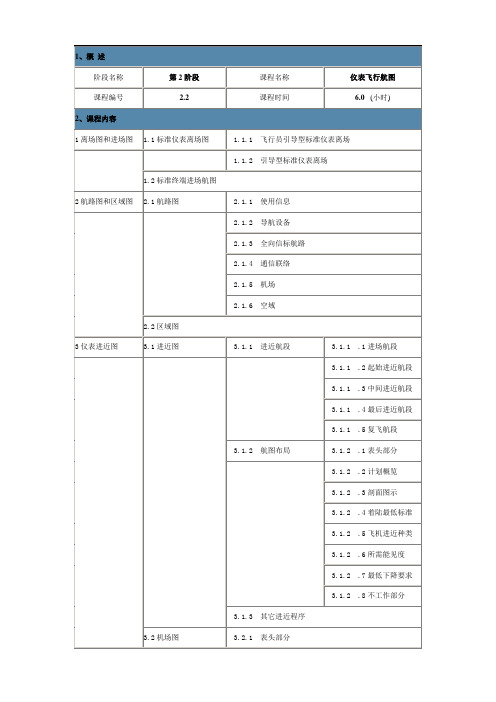
3.1.2 .5飞机进近种类
3.1.2 .6所需能见度
3.1.2 .7最低下降要求
3.1.2 .8不工作部分
3.1.3其它进近程序
3.2机场图
3.2.1表头部分
3.2.2机场概览和使用说明
3.2.3起飞和备降最低标准
2.1.5机场
2.1.6空域
2.2区域图
3仪表进近图
3.1进近图
3.1.1进近航段
3.1.1 .1进场航段
3.1.1 .2起始进近航段
3.1.1 .3中间进近航段
3.1.1 .4最后进近航段
3.1.1 .5复飞航段
3.1.2航图布局
3.1.2 .1表头部分
3.1.2 .2计划概览
3.1.2 .3剖面图示
1、概述
阶段名称
第2阶段
课程名称
仪表飞行航图
课程编号
2.2
课程时间
6.0(小时)
2、课程内容
1离场图和进场图
1.1标准仪表离场图
1.1.1飞行员引导型标准仪表离场
1.1.2引导型标准仪表离场
1.2标准终端进场航图
2航路图和区域图
2.1航路图
2.1.1使用信息
2.1.2导航设备
2Hale Waihona Puke 1.3全向信标航路2.1.4通信联络
仪表等级飞行员理论培训

理论培训的考核标准
ห้องสมุดไป่ตู้
仪表等级飞行员理论培训的考核 内容
仪表等级飞行员理论培训的考核 标准
添加标题
添加标题
添加标题
添加标题
仪表等级飞行员理论培训的考核 方式
仪表等级飞行员理论培训的考核 结果
P仪A表R等T级5飞行员理论培训的实
践应用
仪表等级飞行员在飞行中的实践应用
仪表等级飞行员的基本要求:具备相应的理论知识和技能,能够熟练操作飞行仪表和设备。
法与要求
理论培训的方法
制定培训计划:根据学员的实际 情况和需求,制定合理的培训计 划
教学方法:采用多种教学方法, 如讲解、演示、模拟训练等
添加标题
添加标题
添加标题
添加标题
教学内容:包括仪表等级飞行员 的理论知识、操作技能、安全知 识等
教学评估:对学员的学习情况进 行评估,及时调整教学计划和教 学方法
YOUR LOGO
仪表等级飞行员理 论培训
,a click to unlimited possibilities
汇报人:
时间:20XX-XX-XX
目录
01
添加标题
02
03
04
05
06
仪表等级飞行 员培训的重要 性
仪表等级飞行 员理论培训的 内容
仪表等级飞行 员理论培训的 方法与要求
仪表等级飞行 员理论培训的 实践应用
先进技术的应用:随着科技的不断进步,无人机、人工智能等先进技术的应用将为仪表等级飞行 员培训提供更多的实践机会和培训手段。
国际化趋势:随着全球化的加速,跨国航空公司的不断扩张将为仪表等级飞行员提供更多的就业 机会和国际化发展机遇。
(精品)仪表等级飞行员理论培训stage1-109RNAV-GPS1A

GPS Architecture
The GPS Positioning Concept
• Two principal pieces of information are required to determine a GPS position: ➢Position of each satellite ➢Range from the satellite to the user
What might a Flight Management System do for a pilot?
•Position •Airspeed •Groundspeed •Altitude hold •ETE / ETA •Heading •Course
• Ground Track • Fuel Burn
Once the Waypoint is set up in the receiver, the pilot simply treats it as though it were a real VOR
Programming the RNAV
Flight Management Systems: A Definition
• A minimum of four satellite signals are required to solve for an unaided, unique, position and time solution.
How Does GPS Work? Basic Function of GPS
Ground Antennas
GPS Architecture
User Element
• Consists of antennas and receiver/processors on board an aircraft, automobile, ship, cellular telephones and other new items like watches that provide positioning, velocity and precise timing to the user.
仪表等级飞行员理论培训stage1-103 GYROS-COMPASS
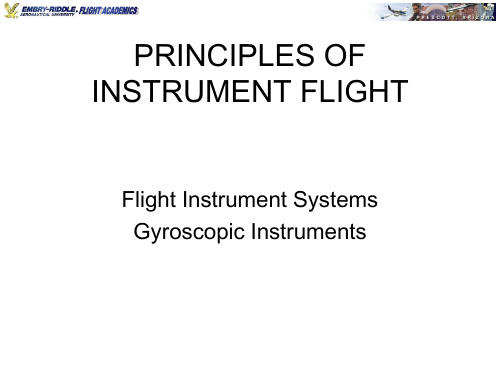
ATTITUDE INDICATOR
How an AI Works
• Principle of operation:
-RIGIDITY IN SPACE
• Gyro spins in horizontal plane on a
models)
• Caging devices were necessary for acrobatic flight to prevent tumbling
• Newer Attitude Indicators do not have the same limits so no caging
Heading Indicator
Acceleration / Deceleration Errors
• Example - accelerate
– Horizon bar moves down
– Incorrectly indicates a climb – ‘Confirmed’ by pilot’s somatogravic
Equipment tests & inspections required for IFR
• Airworthiness Directives (recurring/one-time) • VOR (preceding 30 days) • Inspections (Annual/100 hour if for hire) • Altimeter (preceding 24 calendar months • Transponder (preceding 24 calendar months) • ELT (preceding 12 calendar months) • Static system (preceding 24 calendar mo.)
仪表等级飞行员理论培训stage1-108HSI,ADF,RMI,DME剖析

HSI: FAA Fig. 95
HSI: FAA Figs. 98 & 99
Which aircraft symbol represents the indications of HSI ‘A’, ‘B’, etc.?
– Think of the ‘N’ or ‘0’ at the top of the dial as representing the “NOSE” of the aircraft rather than North.
Movable Card Indicator
–With MH set on movable card ADF • Tip of needle points to magnetic bearing TO NDB • Tail of needle points to magnetic bearing FROM NDB
RANGE REPLY SIGNAL
INTERROGATION SIGNAL
Distance Measuring Equipment (DME)
DME Identification
(Morse code approx. every 30 seconds)
•DME Cautions: Slant Range Distance
ADF Formula
– MH + RB = MB –Magnetic Heading (MH) –Relative Bearing (RB) –Magnetic Bearing (MB) –TO the station
–(add/subtract 180 for FROM)
仪表等级飞行员理论培训sgeHSIADFRMIDME
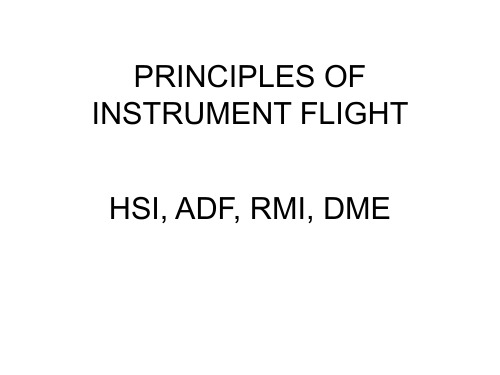
HSI: FAA Fig. 95
HSI: FAA Figs. 98 & 99
Which aircraft symbol represents the indications of HSI ‘A’, ‘B’, etc.?
– Shoreline Effect
• Radio waves travel differently over water than over land.
– Night Effect
• signals bounced off ionosphere - needle fluctuations & interference from distant stations
First note the aircraft Heading, then figure out in which quadrant the aircraft is located
HSI: FAA Figs. 109, 110, 111
What cardinal direction are we located from the VOR station?
– Think of the ‘N’ or ‘0’ at the top of the dial as representing the “NOSE” of the aircraft rather than North.
Precipitation Static
Shorelines Can Refract (Bend) The Signals When They Cross At Small Angles
仪表等级飞行员 理论培训
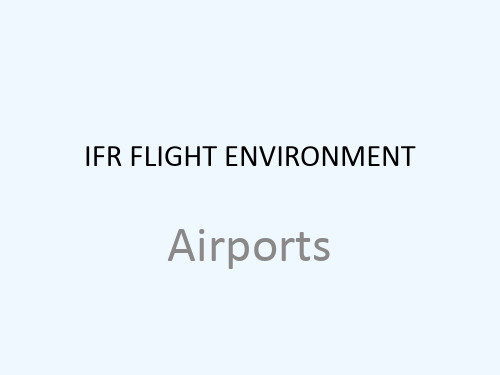
Airport Signs • Most airfield signs are standardized.
LAHSO
• Land and Hold Short Operations
– In effect at some controlled airports
• Could be at:
– Intersecting runway – Intersecting taxiway – Designated point on the runway
– Xs or simply blocked off
• Displaced Threshold
– Begin/end normal operations for takeoff and landing rollout, not fordisplaced threshold
• Determination of available landing distance (ALD)
Lighting Systems
• Approach Light System • Visual Glide Slope Indicators • Tri Color VSI • Runway Lighting • Airport Beacon and Obstruction Lights
intending to land.
Causes of Runway Incursion
仪表等级理论训练大纲-仪表飞行操作
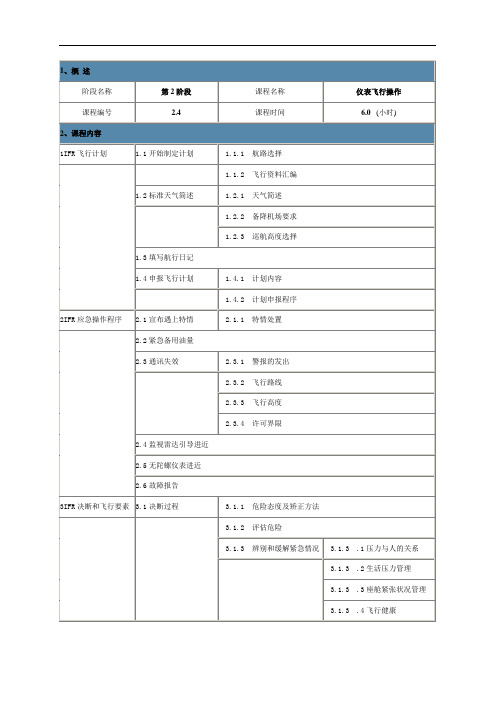
2IFR应急操作程序
2.1宣布遇上特情
2.1.1特情处置
2.2紧急备用油量
2.3通讯失效
2.3.1警报的发出
2.3.监视雷达引导进近
2.5无陀螺仪表进近
2.6故障报告
3IFR决断和飞行要素
3.1决断过程
3.1.1危险态度及矫正方法
3.1.2评估危险
3.1.3辨别和缓解紧急情况
3.1.3 .1压力与人的关系
3.1.3 .2生活压力管理
3.1.3 .3座舱紧张状况管理
3.1.3 .4飞行健康
3.2IFR飞行要考虑的因素
3.2.1设置因素
3.2.2座舱管理
3.2.3自动驾驶仪
3.2.4头戴耳机
3.2.5航空气象
3.2.5 .1航空天气预报的有限性
1、概述
阶段名称
第2阶段
课程名称
仪表飞行操作
课程编号
2.4
课程时间
6.0(小时)
2、课程内容
1IFR飞行计划
1.1开始制定计划
1.1.1航路选择
1.1.2飞行资料汇编
1.2标准天气简述
1.2.1天气简述
1.2.2备降机场要求
1.2.3巡航高度选择
1.3填写航行日记
1.4申报飞行计划
1.4.1计划内容
仪表等级飞行员理论培训stage1-107 VOR
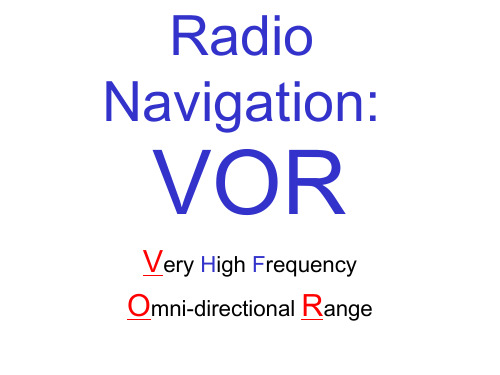
2 centered needles tells you that you’ve arrived at the intersection with 1 receiver, track your course and tune in the off-airway radial with FROM Needle will deflect toward off airway station until you arrive at intersection then it will center and move away from station after you pass the intersection
All aircraft located in a POSITION where flying in the direction
selected on the OBS would take them away from the station will
have a FROM indication
CDI / TO-FROM
CONE OF CONFUSION: over the station
ZONE OF AMBIGUITY: “ABEAM” the station The VOR will indicate “OFF” or “NAV” flag indications when over or abeam the station or when out of range and not receiving a reliable signal.
飞行执照理论之人的因素复习题
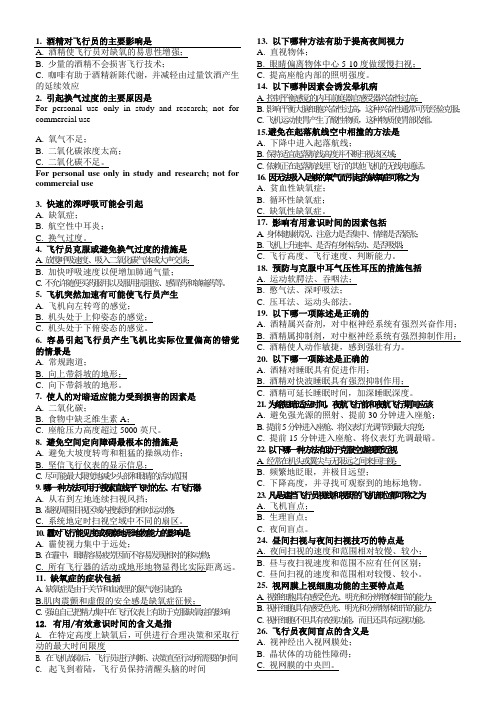
1. 酒精对飞行员的主要影响是A. 酒精使飞行员对缺氧的易患性增强;B. 少量的酒精不会损害飞行技术;C. 咖啡有助于酒精新陈代谢,并减轻由过量饮酒产生的延续效应2. 引起换气过度的主要原因是For personal use only in study and research; not for commercial useA. 氧气不足;B. 二氧化碳浓度太高;C. 二氧化碳不足。
For personal use only in study and research; not for commercial use3. 快速的深呼吸可能会引起A. 缺氧症;B. 航空性中耳炎;C. 换气过度。
4. 飞行员克服或避免换气过度的措施是A. 放慢呼吸速度、吸入二氧化碳气体或大声交谈;B. 加快呼吸速度以便增加肺通气量;C. 不允许随便买药服用以及服用抗阻胺、感冒药和镇痛药等。
5. 飞机突然加速有可能使飞行员产生A. 飞机向左转弯的感觉;B. 机头处于上仰姿态的感觉;C. 机头处于下俯姿态的感觉。
6. 容易引起飞行员产生飞机比实际位置偏高的错觉的情景是A. 常规跑道;B. 向上带斜坡的地形;C. 向下带斜坡的地形。
7. 使人的对暗适应能力受到损害的因素是A. 二氧化碳;B. 食物中缺乏维生素A;C. 座舱压力高度超过5000英尺。
8. 避免空间定向障碍最根本的措施是A. 避免大坡度转弯和粗猛的操纵动作;B. 坚信飞行仪表的显示信息;C. 尽可能最大限度地减少头部和眼睛的活动范围9. 哪一种方法可用于搜索直线平飞时的左、右飞行器A. 从右到左地连续扫视风挡;B. 凝视周围目视区域内搜索到的相对运动物;C. 系统地定时扫视空域中不同的扇区。
10. 霾对飞行能见度或观察地形地物能力的影响是A. 霾使视力集中于远处;B. 在霾中,眼睛容易疲劳因而不容易发现相对的移动物;C. 所有飞行器的活动或地形地物显得比实际距离远。
- 1、下载文档前请自行甄别文档内容的完整性,平台不提供额外的编辑、内容补充、找答案等附加服务。
- 2、"仅部分预览"的文档,不可在线预览部分如存在完整性等问题,可反馈申请退款(可完整预览的文档不适用该条件!)。
- 3、如文档侵犯您的权益,请联系客服反馈,我们会尽快为您处理(人工客服工作时间:9:00-18:30)。
VISION
We obtain most of our orientation through our vision The majority of visual orientation is good but there are some flaws especially when we do not have adequate reference points
CONES
• • Concentrated at the fovea They are useful for detecting color, fine detail, and during high illumination, (photopic vision)
•
•
When exposed to low levels of illumination, cones produce iodopsin.
Flaws are:
• • • • Blind spots Night vision limitations Visual illusions (false horizon, autokinesis) Optical illusions
COMPONENTS OF THE EYE
RODS
• • • • • • Used during low levels of light, (scotopic vision) Found along the retina; used for peripheral vision. Not effective for detecting color or detail. Produce rhodopsin using oxygen. Rhodopsin bleaches quickly if exposed to light There are approximately 20 to 30 times more rods than cones
Sensory Systems for orientation Illusions in flight Physiological and psychological factors Medical factors Aeronautical decision making (ADM) Crew Resource management (CRM) and Single Pilot Resource Management (SRM)
OPTICAL ILLUSIONS
OPTICAL ILLUSIONS
OPTICAL ILLUSIONS
Runway Width illusion Runway and Terrain Slopes Illusion Featureless Terrain Illusion Water Refraction Haze Fog Ground Lighting Illusions
EARS
ILLUSIONS LEADING TO SPATIAL DISORIENTATION
Besides the visual illusions caused by the human eye sight. The sensory system responsible for most of the illusions leading to spatial disorientation is the vestibular system.
CORIOLIS ILLUSION
when a pilot has been in a turn long enough for the fluid in the ear canal to move at the same speed as the canal. A movement of the head in a different plane, such as looking at something in a different part of the flight deck, may set the fluid moving and create the illusion of turning or accelerating on an entirely different axis.
VISUAL ILLUSIONS
False Horizon A sloping cloud formation, an obscured horizon, an aurora borealis, a dark scene spread with ground lights and stars, and certain geometric patterns of ground lights can provide inaccurate visual information, or false horizon, for aligning the aircraft correctly with the actual horizon. The disoriented pilot may place the aircraft in a dangerous attitude. Autokinesis In the dark, a stationary light will appear to move about when stared at for many seconds. The disoriented pilot could lose control of the aircraft in attempting to align it with the false movements of this light, called autokinesis.
PREPARING FOR NIGHT FLIGHT
Avoid bright white light for 30 minutes Preflight using a dim light If you are exposed to a bright light, close one eye to avoid ruining night vision in both eyes Avoid using red lights, as red on the charts will not show up.
Iodopsin makes the cones 100X more sensitive to light
BLIND SPOTS
SCAN TECHNIQUES
• • As you scan, do not scan more than 10 degrees at time. Focus on the area for at least 1 second and allow 1 second for your eyes to focus on the new location.
SOMATOGRAVIC ILLUSION
A rapid acceleration, such as experienced during takeoff, stimulates the otolith organs in the same way as tilting the head backwards. This action creates the somatogravic illusion of being in a nose-up attitude
HUMAN FACTORS
THE ELEMENTS AFFECTING HUMAN INTERACTION WITH OTHER PEOPLE, MACHINES, AND THE ENVIRONMENT THEY ENCOUNTER
ELEMENTS COVERED IN THIS CHAPTER
SENSORY SYSTEMS FOR ORIENTATION
Eyes - maintain visual orientation Ears – motion sensing maintains vestibular orientation Nerves – located throughout the body in the skin, joints, and muscles to maintain postural orientation When conflicting information comes from these 3 systems we become disoriented
•
• • •
For night operations, use off center/peripherals in order to utilize rods
At night don’t focus on an object as it will fade due to autokinesis Scanning continuously to expose new areas of the retina to the light. Develop your scan
Vestibular Illusions The Leans Coriolis Illusion Graveyard Spiral Somatogravic Illusion Inversioin Illusion Elevator Illusion
THE LEANS
when a banked attitude, to the left for example, may be entered too slowly to set in motion the fluid in the ―roll‖ semicircular tubes. An abrupt correction of this attitude sets the fluid in motion, creating the illusion of a banked attitude to the right. The disoriented pilot may make the error of rolling the aircraft into the original left banked attitude, or if level flight is maintained, will feel compelled to lean in the perceived vertical plane until this illusion subsides.
